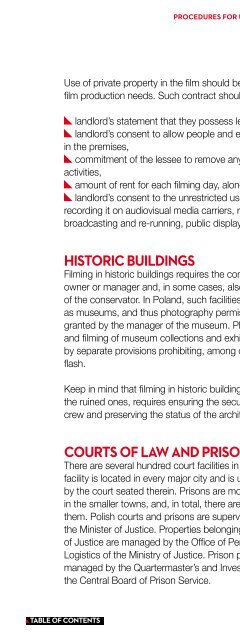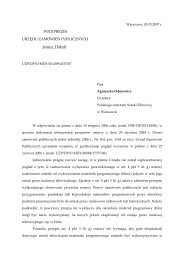Create successful ePaper yourself
Turn your PDF publications into a flip-book with our unique Google optimized e-Paper software.
Table of conTenTs<br />
procedures for using locaTions | <strong>producTion</strong> <strong>guide</strong> <strong>poland</strong> <strong>2013</strong><br />
Use of private property in the film should be preceded by signing a property lease contract for<br />
film production needs. Such contract should include, among others:<br />
landlord’s statement that they possess legal title to manage the premises<br />
landlord’s consent to allow people and equipment necessary for the film production<br />
in the premises,<br />
commitment of the lessee to remove any damages caused as a result of film production<br />
activities,<br />
amount of rent for each filming day, along with the date and form of payment,<br />
landlord’s consent to the unrestricted use of the image of the property in all fields of life,<br />
recording it on audiovisual media carriers, reproducing, marketing, leasing and lending,<br />
broadcasting and re-running, public display, reproduction and posting on the Internet.<br />
hisToric buildings<br />
Filming in historic buildings requires the consent of the<br />
owner or manager and, in some cases, also the consent<br />
of the conservator. In Poland, such facilities often operate<br />
as museums, and thus photography permission must be<br />
granted by the manager of the museum. Photographing<br />
and filming of museum collections and exhibits is regulated<br />
by separate provisions prohibiting, among others, the use<br />
flash.<br />
Keep in mind that filming in historic buildings, especially<br />
the ruined ones, requires ensuring the security of the film<br />
crew and preserving the status of the architectural object.<br />
courTs of law and prisons<br />
There are several hundred court facilities in Poland. A court<br />
facility is located in every major city and is usually managed<br />
by the court seated therein. Prisons are more often located<br />
in the smaller towns, and, in total, there are several dozen of<br />
them. Polish courts and prisons are supervised by<br />
the Minister of Justice. Properties belonging to the Ministry<br />
of Justice are managed by the Office of Personnel and<br />
Logistics of the Ministry of Justice. Prison property is<br />
managed by the Quartermaster’s and Investment Office of<br />
the Central Board of Prison Service.<br />
Ministry of Culture and National Heritage<br />
Department for Protection of Monuments<br />
Ministerstwo Kultury i Dziedzictwa<br />
Narodowego<br />
Departament Ochrony Zabytków<br />
02-656 Warsaw, ul. Ksawerów 13<br />
tel. +48 22 646 05 27, fax +48 22 848 53 53<br />
doz@mkidn.gov.pl,<br />
www.mkidn.gov.pl<br />
Ministry of Justice<br />
Office of Personnel and Logistics<br />
Administrative Division<br />
Ministerstwo Sprawiedliwości<br />
Biuro Administracyjno-Finansowe<br />
00-950 Warsaw, Al. Ujazdowskie 11<br />
tel. +48 22 521 25 59, fax +48 22 521 25 23<br />
www.ms.gov.pl<br />
Central Board of Prison Service<br />
Quartermaster’s and Investment Office<br />
Centralny Zarząd Służby Więziennej<br />
Biuro Kwatermistrzowsko-Inwestycyjne<br />
02-521 Warsaw, ul. Rakowiecka 37A<br />
tel./fax +48 22 640 85 11, +48 22 640 85 12<br />
bkw@sw.gov.pl,<br />
www.sw.gov.pl<br />
company index<br />
47








